
Article: M. Reksoprodio, H.Mulijadi, I. Trihapsoro, W. Mulyawan
The aeromedical evacuation
Indonesian Armed Forces /TNI Experiences
Aeromedical Evacuation (AME) is the best choice for a rapid and relatively safe evacuation using air transportation. AME has
several limitations caused by environmental influences on the human physiology. The operation of AME can work well when there
is a good support organisation in place.
Preface
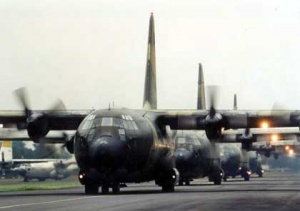 C-130s being
used for
strategic
AirMedEvac
C-130s being
used for
strategic
AirMedEvac
It is known that a war or even at the low levels conflict, we cannot avoid falling victims or casualties. The victims should receive good treatment. Health facilities on the front lines are generally very limited. Therefore, victims should immediately evacuate to a higher-level equipped hospital in the rear. One of the best choices to rapid and relatively safe evacuation is using air transportation, as known as aero medical evacuation (aero medevac). The movement of seriously ill or injured patients to medical facilities was pioneered and to a large extent perfected by military forces. From the “flying ambulances” of Napoleonic times to modern jet aircraft flying intensive care wards, a major part of our experience with the transport of patients over the years derives from military medical care.
Medical evacuation, often termed MEDEVAC or medivac, is the timely and efficient movement and en route care provided by medical personnel to the wounded being evacuated to receiving medical facilities using medically equipped ground vehicles (ambulances) or aircraft (air ambulances). In modern American military terminology, Medevac is often differentiated from Casualty Evacuation (casevac). In this context, casevac refers to the moving of a patient either from the point of injury, or a casualty collection point, to a medical facility or between the different levels of care with en route medical care whereas medevac has limited or no en route care and medical equipment. Casevac is heavily utilized by the US Marine Corps and manned by US Navy Hospital Corpsman; its helicopters are combat aircraft and will, as needed, land in 'hot zones' medevac helicopters would not, due to hostile fire.
The term aero medevac is commonly applied to a vehicle, fixed-wing aircraft, or helicopter used as an ambulance (sometimes called an "air ambulance") provided with definitive medical care in route. This permits the rapid transport of seriously injured persons, particularly trauma patients, from the scene of the accident to the hospital. The term Medevac usually is used for the evacuation patient from medical facilities to higher level medical facilities. It can be divided to land medevac, sea medevac and air medevac (AME) or Pengungsian Medik Udara (PMU). According our Indonesian Air Force SOP (Standard Operating Procedure), Air Medevac/AME is evacuation patients from one medical facility to higher-level medical facilities using air transportation and accompanied by medical attendants. But for the term casevac, according the UN medical SOP, is used for evacuation victims from the point of injury, or a casualty collection point, to a medical facilities and we called air casevac and use usually helicopter.
Aero Medevac in History
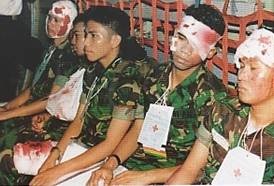 AME training
AME training
The experience of American military forces over the last century illustrates the efficacy of early rescue and rapid transport of the patient to a facility for stabilization. The mortality rate of patients evacuated from the battlefield to a medical facility was reduced from 8.1 percent in World War I to 2.5 percent in Vietnam, and the casualty fatality rate of 27 percent in World War II reduced to 17 percent in Vietnam. Survival is dependent on early identification of the victim, life-saving care at the scene, and rapid transport of the victim to a hospital for stabilization.
In Vietnam War, almost all (over 90 percent) of medical evacuation was done by air. From the site of wounding, patients were taken by any means possible to the helicopter landing site, from which they were usually taken directly by helicopter to a hospital. This is known as forward medevac. The others types is tactical and strategic medevac. During Operation Desert Shield, the aeromedical evacuation performed 242 C-130 aeromedical evacuation missions were flown, transporting 2,136 patients. During Operation Desert Storm, 173 C-130 missions were flown which transported 2,375 patients, including Coalition and Iraqi casualties.
Indonesian Armed Forces/TNI Experiences
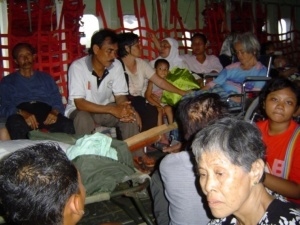 Tsunami refugees from Aceh evacuated to Medan
Tsunami refugees from Aceh evacuated to Medan
TNI has experienced in conducting aero medevac, both tactical or strategic aero medevac. Besides aero medevac for military purposes, TNI also provide and support the aero medevac for civilian problems, such as disaster in many islands in Indonesia, using many kind of aircfrafts. When Trikora Operation performed in 1960, TNI using 6 C-47 Dakota as air ambulance, based in Mandai AFB, Makasar. In East Timor, during Seroja Operation tactical medevacs were done to evacuated casualties to Penfui AFB in Kupang using Puma helicopter, Super Puma, Super Frelon, Bolkow, Iroquois and Hughes. TNI also used fixed wing like CASA, Dakota and Albatross. Tactical aero medevac from battlefield to Dili: 1975-1976 evcuated 473 casualties, in 1977 1.717 victims, 199 die, in 1978 2.096 victims including 276 fallens and in 1979 1.155 victims including 59 fallen. In 1975–1979, strategic aero medevac were conducted for 3.776 casualties from Dili to Navy Hospital in Surabaya and Army Central Hospital, Jakarta, they Used 158 sortie of Hercules, 44 sortie F-27 and 1 sortie C-47 Dakota.
Air Medevac Organisation
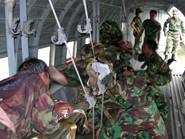 AME in a Dakota
AME in a Dakota
The operation of this aero medevac can work well when there is a good aero medevac organization. All the treatments have to well documented since in the referring hospital, during the trip and confirmed received by the destination hospital. In TNI AU (Indonesian Air Force), Chief of Health Service coordinated the AME execution. He will order Chief of Aeromedical Service to plan the AME, and then Chief of Health Service of I/II TNI AU Operation Command will technically coordinating the AME with AME team.
The AME
 AME II
AME II
Team consists of Medical Team I, II, III. Team AME I, lead by a flight surgeon in departure airbase, responsible of patient selection (medical clearance) and preparing all medical document, food, security, preparing physical and mental of the patient, and assisting the Team AME II loading the patient to the aircraft. The team AME II, lead by flight surgeon or senior flight nurse is responsible since hand over the patient from team AME I, during the flight and until unloading patient in destination air base. They must join the pre flight briefing and reporting to captain in command of the aircraft. Team AME III at destination air base are led by flight surgeon or Chief of TNI AU Medical Service at arriving airbase. They also are helped by medical personnel of military or civilian medical services in which responsible to receive (d) the patients with its ambulance to destination hospital. To conduct the AME, there are needed some supports. These are personnel support, medical logistic support and also medical administration support. Each support must correlate with each other. The personnel supports are AME Medical Team I, II, III. The medical logistic support are Flight Nurse kit, Flight Surgeon kit, Air Ambulance kit and Ambulance kit, while medical administration support are the data of the patients pre, during and post flight.
The Aircraft
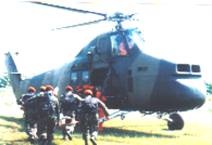 Forward
AME
using a
helicopter
Forward
AME
using a
helicopter
There are several types of aircraft which can be used in Aeromedical Evacuation as well as pressurized or non pressurized cabin fixed wing or rotary wing, both from military or civilian aircraft. The working area inside aircraft is much smaller than in a hospital setting. The low cabin height will reduce (s) the pressure head for IV lines. The limited dimensions make handling of large stretcher patients, or those with splints, become difficult.
Restrictive cabin dimensions did limitations on patient positioning and minimal space for setting up or for resuscitation. Mobile environment can expose to sudden movements, which can cause injury or damage. Equipment access must be kept secured but still within reaching distance by medical personnel. The equipment portability and power supplies must able to be operated independently from the aircraft power supply. The maximum take-off weight and centre of gravity must be considered during setting patients. This may compromise the number of patients who can be carried and their relative positioning in the aircraft. High temperatures, short airstrips and the requirement to take additional fuel for long distance flights or
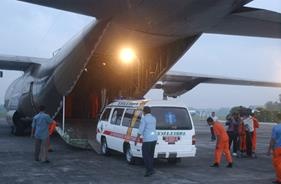 AME I vehicle being loaded
AME I vehicle being loaded
due to weather, will further reduce the payload. The Communication will be impaired in the noisy environment. Temperature and humidity will affect the performance of procedures and concentration. Adequate illumination is required for observations and procedures. Some dangerous and corrosive items such as mercurial thermometers, batteries, oxygen, body fluids such as liquor, urine or blood must be avoided (since cause damage the aircraft). The personnel must conduct safety drills like safety procedures since most patients pose problems for rapid evacuation. Etiquette of flying must also be applied during various phases of flight. Medical personnel must also practice rules and regulations related to aircraft operation.
The Medical Equipments
These are the essentials medical equipments are needed in transporting the patients (in) with aircraft. Every personnel must familiar with these equipments
- Resuscitation Set + Oxygen
- Ambu Bag
- Intubation Set
- Suction Apparatus
- Sphygmomanometer
- Infusion & Infusion Set
- Iv Catheter & Cvp Set
- Bandages
- Fixation Tools & Splints
- Vacuum Mattress
- Injection Set
- Minor Surgery Set
- Gastric Tubes
- Portable ECG & Defibrillator
Drugs and consumables need to be stored in compact containers. Essential medical equipment has to be kept secured but still within reach. Every crewmember must know exactly what is on board and where it is, so (as) not to be dependent on other crewmembers in an emergency.
TNI AU Air Medical Container
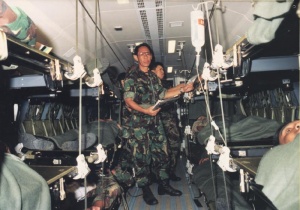 Inside a CN-235
Inside a CN-235
The Air Medical Container (AMC) is one of TNI AU assets operated by TNI AU Health Service. The capability of air medical container is to accomplish a mission on air evacuation equipped with the high tech and operated by the skillfull personnel. The characteristic of Indonesian air medical container is ground level. What does it mean? It means that the pressure inside the container is almost the same as the pressure on the ground level. Eventhough the container is flown at an altitude of 20.000 feet above, the inside of the container is almost the same as the ground level. This AMC is compatible with Hercules C-130 H. It has own generator and x-ray unit. AMC can be functioned as ICU or operation room. This AMC is the assets of TNI AU as air ICU.
The AMC TNI AU has been operated for more than 20 years with very large scales of experiences. From backing up of Indonesian President in every important visit, looks like ASEAN meeting in Philippines in late 80’s, to transporting soldiers who has severely illness injury in the recent time.
The AMC TNI AU personnel consists of doctors, highly skilled paramedics, and 1 equipments expert. Some specialty doctors, for instance intensivist, cardiologist, surgeon, and internist, are on board depending on purposes. The highly skilled paramedics usually consists of 1 intensivist assistant, 1 OR nurse, and 1 circulating nurse. An equipments expert responsible for making coordination with aircraft personnel, and maintaining all AMC and medical devices. Above all, one of specialty doctors will be chosen as AMC leader, depending the purpose of mission.
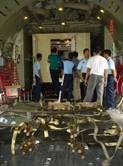 The AMC
inside a C-130
The AMC
inside a C-130
The average time for preparing AMC from the hospital base (eq : TNI AU Central Hospital) to the nearest air force base (eq : Halim Air force Base), including preparing equipments, is around 2 hours, and then the average time for C-130 to be ready in targeted air force base is around 1–5 hours (Jakarta to Yogjakarta is less than one hours, but Jakarta to Papua is more than 4 hours). So, total average time for AMC TNI AU to be available in the targeted air force base that asking for service is around 6 hours. With all aspects of decision making, coordinating, etc, usually all mission will be accomplished in less than 24 hours.
Physiological Considerations
Aeromedical transport exposes patients and their medical attendants to an altered physical environment, as well as an altered working environment. The former will have significant physiological effects on both patients and crew whilst the latter may restrict the ongoing management of the patients' clinical problems. Altitude hypoxia occur when arterial pO2 fall from about 100 mmHg at sea level to around 60 mmHg at 10,000 ft. Dysbarism occur when there is expansion of gases at altitude. Vibration and turbulence induced by engines and aerodynamics of the airframe can interfere the function of the equipments, the illness of the patients, and even the concentration of the medical personnel. Noise will affect communication and auscultation. Patients and crews are exposed to a broad range of temperatures called thermal stress. The aircraft also has acceleration and deceleration during take off and landing, so vestibular disturbances can cause motion sickness in patients and crew.
Tactical Medevac
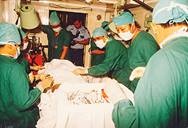 Surgery
being
performed
in the
AMC
Surgery
being
performed
in the
AMC
The medical officer of the referral medical facilities or hospitals must conduct patient selection and preparation thoroughly to survive in the use of the air transportation. These officers have to identify several disease conditions that have a high risk of flight and must do the proactive action to get the patient survived. Tactical medevac conducts when still in operation theaters (to) referring the casualties to better and safe local hospital. It’s conducted by AME Medical Team I. Base of patients selection is indication and contraindication. Usually use light or medium aircraft. These are some contraindication to perform tactical aero medevac such as critical casualties, quarantine illness (infectious status), lung TB (infectious stadium), shock, severe anemia (HB <
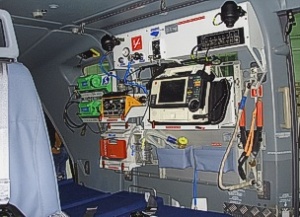 On-board
medical
equipment
On-board
medical
equipment
10%), acute ischaemic heart diseases, acute myocardiac infarct, uncontrolled epilepsy, aggressive mental illness, lung diseases with respiratory dysfunction, pregnancy > 32 weeks and infant < 10 days.
Strategic Medevac
Strategic medevac is performed to get the casualties out of operation theaters. One of its purposes is to decrease AFB workload in operation area, and conducted by tight selection and only for those who really needed further medical assistance. As a consequences is a status change from combat personnel to non combat personnel. and Usually using heavy transport aircraft. Patients in whom aeromedical transport is NOT indicated are terminally ill patients (not) suffering from an acute incorrectable medical problem, "No code" or "Do not resuscitate" patients and patients in full arrest at the referring institution who cannot be stabilized with a perfusing circulation prior to transport
Conclusions
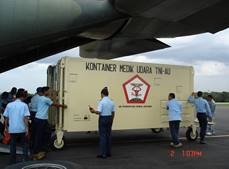 Air Medical Container
Air Medical Container
AME is the best choices to rapid and relatively safe evacuation (is use) using air transportation. Aero medevac has several limitations caused by environmental influences on the human physiology. The operation of this aero medevac can work well when there is a good aero medevac organization
Date: 03/28/2018
Source: MCIF 2/2011











